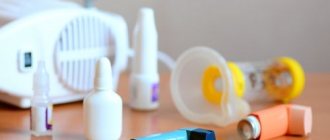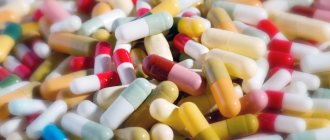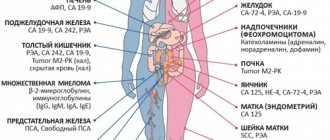Antibiotics are used to treat and/or prevent certain types of bacterial infections. They act on pathogens in two ways: bactericidal (killing bacteria) and bacteriostatic (preventing their reproduction).
Antibiotics are ineffective against viral infections (influenza, ARVI) and are rarely used for the treatment of mild bacterial diseases, when the immune system is able to cope with pathogenic microbes on its own. The drugs are prescribed for the treatment of acute and chronic bacterial infections, in the postoperative period, when the risk of more serious complications is high. For some patients, a course of medication is indicated as a preventative measure (antibiotic prophylaxis).
Types of antibiotics
There are hundreds of different types of antibiotics, but most can be roughly divided into six groups:
- Penicillins are widely used to treat various infections: skin, respiratory system, urinary tract.
- Cephalosporins are used to treat a wide range of serious infections, including sepsis and meningitis.
- Aminoglycosides are prescribed mainly in hospitals (outpatient - under the strict supervision of a doctor) for the treatment of severe pathologies. This group of drugs can cause serious side effects: hearing loss and kidney pathology. Aminoglycosides are used, usually in the form of injections or eye/ear drops.
- Tetracyclines are used to treat a wide range of infections: skin (severe forms of acne and rosacea), urogenital.
- Macrolides are prescribed for infectious processes in the lungs and/or as alternative drugs for patients with allergies to penicillin. They are also used to treat penicillin-resistant strains of bacteria.
- Lincosamides are effective in the treatment of infectious bone lesions.
Follow the instructions. If you drink it with water
Tea, coffee, orange, apple and any other juices, milk and dairy products - in most cases, all this is not suitable for washing down antibiotics intended for oral administration. These drinks speed up the elimination of the drug and may reduce the effectiveness of treatment. 5 Juices also contain various acids that can react with medications and cause unwanted reactions.6
It is most rational to use water when taking medications, unless otherwise indicated in the instructions. Be sure to read it before starting treatment. Tea and coffee are also undesirable because they contain caffeine, tannins and catechins, which can alter the absorption and pharmacological action of many drugs.7
How to take antibiotics correctly
It is important to take antimicrobial medications correctly to prevent the development of resistance, a condition where a strain of bacteria no longer responds to treatment with one or more types of antibiotics. Therefore, self-medication in the case of antibiotics is not just harmful to health - it is dangerous!
Only a doctor should decide on the advisability of prescribing an antimicrobial agent, select a specific drug, dosage and determine the duration of use.
Antibiotics should be used strictly in the doses prescribed by the doctor. Oral forms (tablets, capsules, syrups) are drunk in accordance with the recommendations prescribed in the instructions: before/after meals. You cannot reduce or increase the dosage on your own: a low level of the active substance in the blood will not have the desired effect, and an excessive one will increase the risk of side effects.
It is very important to drink the entire prescribed course of antibiotics, even if the temperature has subsided and your health has improved. Stopping use risks the emergence of resistant forms of bacteria. You cannot skip taking the next dose: the effect of the medicine must be continuous, that is, one portion of the substance “clings” to another. Interruptions in admission are unacceptable. If you accidentally miss one dose, drink the medicine “as soon as you remember”, and then continue the course as usual. Do not take a double dose to make up for a missed dose.
Antibiotics for viral diseases
Often, general practitioners prescribe antibiotics to their patients, such as Cetrin, at the first symptoms of the disease. They are taken in combination with antiallergic, antiviral and anti-cold medications. The question arises: “Do experts really not see the difference between a viral and bacterial infection?” Naturally, they see it. It is also clear to everyone that few people, after receiving a diagnosis of ARVI, will remain in bed and undergo treatment.
In reality, complications should not appear. A healthy body with a strong immune system is able to overcome seasonal diseases in 4-6 days. The patient must provide the body with all the necessary conditions: maintain bed rest, drink as much water as possible, ventilate the room.
In reality, few people follow these rules. Many continue to go to work and do household chores, which is why the illness can drag on for several weeks. As a result, active proliferation of microbes occurs in the body. Antibiotics then help prevent the spread of bacteria.
Are probiotics necessary?
Antibiotics kill bacteria, but they do not distinguish good microorganisms from bad ones. These powerful drugs destroy vital bacteria necessary for the normal functioning of the digestive and immune systems. The best way to replenish losses is to consume probiotics, which contain live bacteria that normally inhabit the intestines.
Probiotics are prescribed during and after a course of antibiotics to restore intestinal microflora and, therefore, immunity. It is important to “dilute” the intake of medications: it is advisable to take the probiotic a couple of hours before or several hours after the dose of the antibiotic. The duration of use of probiotics after a course of antibiotic therapy is determined by the doctor.
For detailed advice on how to take antibiotics correctly, please contact your healthcare provider.
Myths and facts about antibiotics
Antibiotic therapy, like vaccinations, is shrouded in myths, fears and stories of how someone lost their hearing after treatment with antibiotics, got a persistent intestinal disorder, and in general, antibiotics are too dangerous because they kill all living things.
Briefly: yes, antibiotics have serious side effects and, if prescribed incorrectly, can actually cause hearing problems, etc. There are drugs prohibited for children and pregnant women, but in general modern drugs are safe if taken as directed. And now in more detail
For seriously ill patients
Express diagnostics at home. This includes not only taking diagnostic samples, but if necessary, we perform ECGs and ultrasounds at home.
A little history:
At the end of the 19th century, several scientists immediately noticed that penicillin fungus mold accelerates the healing of wounds, but its use was difficult - even with short-term storage, the beneficial properties of the mold were lost. In 1938, scientists from Oxford isolated penicillin in its pure form, for which they received the Nobel Prize. And Zinaida Ermolyeva is considered the mother of domestic antibiotic therapy - in 1942 she developed the first Soviet antibiotic, Krustozin, which immediately found use in military hospitals - mortality from bacterial complications fell sharply. Today there are a great variety of antibiotics; there are even drugs with a cytostatic effect that stop the growth of tumor cells.
The most popular question: are antibiotics and alcohol compatible?
Briefly: there are antibiotics that can be taken with alcohol, and there are those where drinking alcohol is contraindicated. In general, it is better not to stop antibiotic therapy because of a glass of wine, but to abstain from alcohol throughout the entire treatment phase.
Read more: it is better to avoid drinking alcohol during treatment, but for most antibiotics it makes no difference whether you drank or not. However, there are exceptions: some drugs slow down the breakdown of alcohol, this increases the concentration of acetaldehyde, causing unpleasant symptoms, including vomiting. Previously, alcoholism was treated with such antibiotics. Where do the roots of this myth come from: during the war, the production of antibiotics was too expensive, they were isolated repeatedly from the urine of patients, and since beer increased the volume of urine and complicated the process, drinking was banned. Another opinion is that venereologists, when prescribing antibiotics, forbade drinking in order, firstly, to punish patients, and secondly, to reduce the likelihood of accidental contacts and further spread of infection.
Conclusion: it is better to give up alcohol so as not to increase the load on the liver and other organs.
Do you have to complete the course to the end?
Complex issue. Modern pharmacology strives to reduce the time of taking the drug while maintaining the effect. Today, single-dose antibiotics have been developed. Previously, it was believed that by not drinking the course to the end, we increase the resistance of microorganisms. But she appears anyway. Studies have confirmed that a short “impact” course is no different in effectiveness from a long one, and resistance is reduced. Most likely, this is due to the fact that resistant bacteria will remain so, but with long-term antibiotic therapy they will also learn to protect themselves from medicinal components, that is, they will gain additional benefits. At the same time, scientists discovered another interesting feature: bacteria from the walls of the cave, which was hidden from people for about 4 million years, were resistant to at least one modern antibiotic! Moreover, antibiotics are a product of the vital activity of microorganisms; bacteria have been using them for 2 billion years.
Not long ago it turned out that bacteria can destroy antibiotics and this feature is fixed at the genetic level, fixed in DNA - this is how superbugs are obtained. In addition, at the source of infection, bacteria are having their own “war” for territory. Some bacteria destroy others, picking up DNA residues that may contain a resistance gene. Does this mean we will all die from superbugs? No. We must not forget that we have an immune system, and scientists are also developing drugs that do not allow the resistance gene to attach to the transport components of bacteria - plasmids - it is the plasmids that are responsible for the transfer of genetic information.
Be sure to complete the course if an antibiotic is prescribed to treat a chronic infection or severe infections. In acute cases, when treating, for example, acute otitis media, if the condition significantly improves, consult a doctor to adjust your medication schedule; perhaps the doctor will stop the antibiotic, or perhaps not. Everything is individual.
Injections are better
No, injections are not better. Previously, the release of dosage forms that would retain the required bioavailability, storage properties and would not be destroyed in the stomach would be problematic, so doctors preferred injections, especially if the infectious process had gone too far. Today, even in hospitals they try to prescribe tablet forms whenever possible. Their bioavailability is practically not inferior to injectable forms, the only thing is that the tablets begin to act a little later. The exceptions are intravenous injections - the antibiotic acts almost instantly and drugs that are destroyed by enzymes. Injections are painful, stressful especially for children, there are the classic risks of infection, and there is also the risk of abscesses and other complications.
Do you take antibiotics for prevention?
Briefly: yes and no.
Taking a pack of pills to avoid getting sick after hypothermia is not prevention. The so-called preventive use of antibiotics is justified if there is a high risk of severe or dangerous infections. Thus, antibiotic prophylaxis is often prescribed in venereology and other areas of medicine. The norm is to take an antibiotic tablet before and after tooth extraction, installation of a dental implant, and during surgical interventions. Antibiotic prophylaxis is prescribed only by a doctor.
Antibiotics are evil for children and pregnant women
You can often find a pregnant woman who tries to treat infectious processes with home methods, believing that the medicine will harm the unborn child. You need to be aware of the risks first of all: the doctor, of course, tries to minimize the use of medications during this period, but pregnant women undergo operations, dental treatment, a lot of other procedures, and refusal of antibiotics where necessary can lead to infection of the fetus including. WHO regularly updates the list of drugs for pregnant women and children. There are recommended, controlled and spare ones. If you are worried, go to the WHO website - approved drugs are highlighted in green, prohibited drugs are in red, controlled and spare drugs are in yellow.
Without a sensitivity test, there is no point in taking antibiotics
In typical cases, conditions of moderate severity and for obvious reasons - some infectious processes have too typical a clinical picture, which is used as a diagnostic criterion; there is no practical sense in an antibiogram.
How an antibiogram is performed: the doctor takes material, for example, from a wound. In the laboratory, a microorganism is isolated that causes an infectious process (this takes at least 2-3 days), then a pure culture is isolated and, roughly speaking, confetti-sized disks are laid out, which are soaked in an antibiotic. Around the most effective ones there will be a maximum clean zone from bacterial colonies. On average, an antibiogram takes 3-7 days to prepare. Treatment ALWAYS begins immediately; during the course of treatment, the antibiotic may be changed, taking into account the antibiogram data. It is not done in all cases, but in the treatment of chronic infections, complex extensive infections. In typical cases, data show that the effectiveness of first-line antibiotics is not much lower than those selected using an antibiogram.
Do I need to take antibiotics for viral infections?
In short: sometimes you need it, sometimes you don’t.
Antibiotics do not act on viruses, but bacterial complications often develop against the background of viral infections. Often the doctor prescribes antibiotics because patients are waiting for appointments, although physical methods are almost always sufficient to treat acute respiratory viral infections, including influenza. Very rarely, an antibiotic for ARVI is prescribed prophylactically if the patient is weakened, has immunodeficiency, extremely low body weight (in children), or old age.
Antibiotics kill all living things and “burn out” the flora
In short: more likely no than yes.
Antibiotics do not kill any microbial cell; they act selectively, taking into account the biochemistry and characteristics of pathogenic agents - the drug either destroys the wall of the microbial cell, or stops reproduction, or acts on another target. The antibiotic only partially affects “its own” people, but already 3-5 days after the end of the course, and for the majority, after 1-2 days, the intestinal microflora is restored without additional intake of probiotics. There is an opinion that probiotics are useless: in case of serious violations of the flora, they do not help, and a conditionally healthy person recovers on his own after a course of antibiotics. Stories that someone once took a loading dose of an antibiotic and now has dysbiosis for life are fairy tales. But if you want to speed up the restoration of flora, drink kefir.
Antibiotics spoil the immune system and a healthy body is able to cope with infections on its own
Briefly: yes and no
Indeed, for some infections, the doctor does not prescribe an antibiotic. For example, for deep abrasions that have become inflamed, dressings and regular washing are enough, antibiotic therapy for bronchitis and pharyngitis is not always prescribed. But the body cannot cope with all infections on its own. Peritonitis, in general, occurs because you couldn’t handle it yourself. Antibiotics do not affect the immune system: the medicine works separately, and the immune cells work separately. Standard antibiotics do not affect the immune system, but there are antibiotics that are initially cytostatic, and they are called antitumor, and for a number of primary immunodeficiencies, antibacterial drugs are taken for several years.
Express replies:
Do antibiotics damage the liver? No. There are drugs that multiply the side effects of each other. Tell your doctor what medications you are taking so he can choose safe antibiotics.
How to drink it? Read the instructions or ask your doctor. Usually antibiotics are taken 1-2 hours after meals with water. You can’t use milk, kefir, jelly or anything else - the active substance is destroyed.
How to recycle? Expired medications should not be flushed down the drain - they have their own life there, which creates resistance to the drugs. Some cities have collection points for expired medications; if they are not available, pour the medications with sand or soil into a plastic container and dispose of them with household waste. This will reduce the risk of children or animals eating the pills.
Antibiotics should not be given to patients with allergies. Can. If an antibiotic provokes an attack, which most often ends at the level of urticaria and is stopped by a single dose of antihistamines, then another one is selected. Abscesses and purulent inflammations are much more dangerous than short-term urticaria. Modern drugs are synthetic and extremely rarely cause allergies; allergy symptoms often occur against the background of massive death of microorganisms.
Modern meat is laced with antibiotics and is dangerous . No. Antibiotics have always been used in animal husbandry; they in no way affect the human body. There are acceptable standards, farmers are obliged to comply with them.
Conclusion : the prescription of antibiotics must be justified, and the duration of the course is selected individually, taking into account the severity of the condition, danger and characteristics of the infectious process. When a doctor prescribes the same regimen for everyone, this is not entirely correct; drugs need to be selected individually - this concerns the dose, frequency of administration and other features. In our clinic you will find excellent specialists who select treatment in such a way as to cure you in the shortest possible time and without delayed risks to the body. We issue sick leave certificates, we have our own laboratory where you can test for sensitivity to antibiotics, including
Individual selection of combinations
Sometimes a combination of medications is required, due to which synergism occurs - an increase in the pharmacological effect. The combination of drugs with each other, taking into account the dosage and type of action on the pathological process, allows you to increase the effectiveness of the treatment. At the same time, you can take both different types of antibiotics and a combination of antibiotics with other drugs. But only a doctor selects a regimen and draws up a treatment plan.
Independent experiments “shouldn’t I also take this pill, it helped my friend” can lead to unpredictable consequences.
How to treat a sore throat?
You can try Strepsils® Intensive, lozenges [orange] containing flurbiprofen, an anti-inflammatory drug from the group of propionic acid derivatives that has an analgesic effect.
Strepsils® Intensive lozenges [orange] help reduce swelling, eliminate difficulty swallowing and combat pain, discomfort and irritation in the throat. It can be used for viral, bacterial and fungal diseases. 10
Directions for use and dosage 10
Adults and children over 12 years of age: Slowly dissolve one tablet every 3-6 hours.
Maximum daily dose: 5 tablets.
The duration of treatment is no more than 3 days. If symptoms persist or worsen after taking the drug for 3 days, you should stop treatment and consult a doctor.
Before using the drug, read the instructions.
You can also use Strepsils® Intensive spray for topical use dosed with flurbiprofen. The drug penetrates the throat tissue and acts on the cause of pain – inflammation. Helps relieve sore throat. The interval between doses of the drug is up to 6 hours. It is recommended to take 1 dose of the drug every 3-6 hours, but no more than 5 doses within 24 hours. eleven









